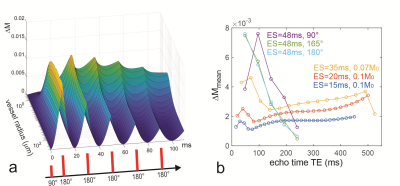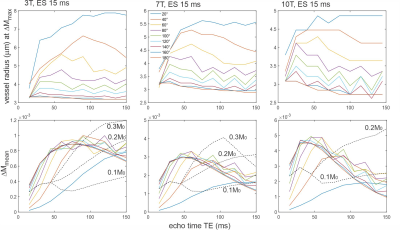Klaus Scheffler1,2, Joern Engelmann1, and Rahel Heule1,2
1Max Planck Institute for Biological Cybernetics, Tuebingen, Germany, 2University of Tuebingen, Tuebingen, Germany
1Max Planck Institute for Biological Cybernetics, Tuebingen, Germany, 2University of Tuebingen, Tuebingen, Germany
The BOLD-sensitivity with vessel diameter in
CPMG depends on echo spacing and refocusing flip angle, and is shifted towards
larger vessel radii for lower refocusing flip angles. The mean BOLD sensitivity
averaged over a range of vessel sizes is not reduced for low refocusing flip
angles.

Fig 3. a: Signal change as a function of vessel size
calculated in time steps of 0.4 ms along a multi-echo spin echo train with
perfect 180° refocusing pulse at 7T with echo spacings of 20 ms. The (gradient
echo-like) profiles immediately before and after later refocusing show
increasingly less sensitivity to larger vessels. b: Mean signal changes along
GRASE echo trains at 7T using echo spacings of 15, 20, 35 with variable
refocusing flip angles that target an echo amplitude of 0.1 and 0.07 M0
(6, 8) and 48 ms echo spacing with constant refocusing flip angles of 165° (9)
as well as 90° and 180°.

Fig. 2. Top row: Size of vessel radius with maximal
signal change DM0 as a function of echo time and field strength
and refocusing flip angles. For small refocusing pulses the vessel radius with
maximal signal change increases with echo number. Bottom row: mean signal
change (averaged across vessel radius) as a function of constant refocusing
flip angles from 20° to 180°, and for varying refocusing flip angles with
target echo amplitudes of 0.1, 0.2 and 0.3 M0. These flip angles were
calculated for field strength dependent relaxation times according to the
algorithm given by Busse (10).